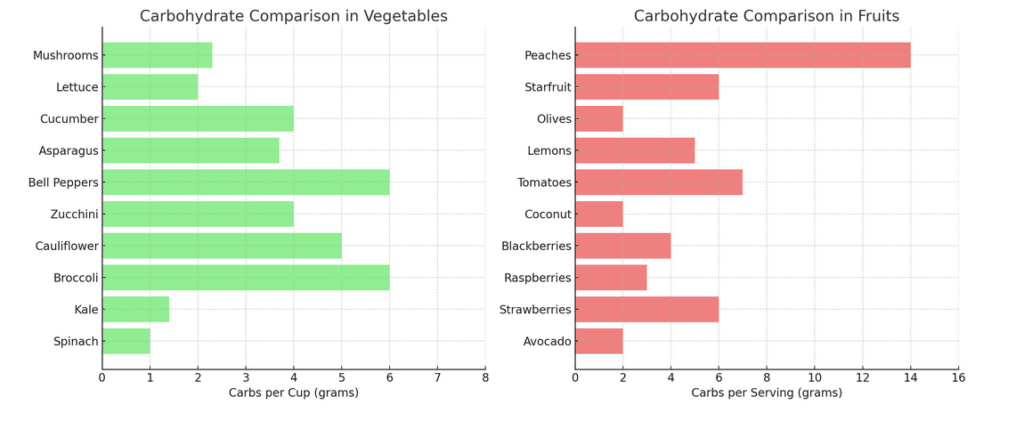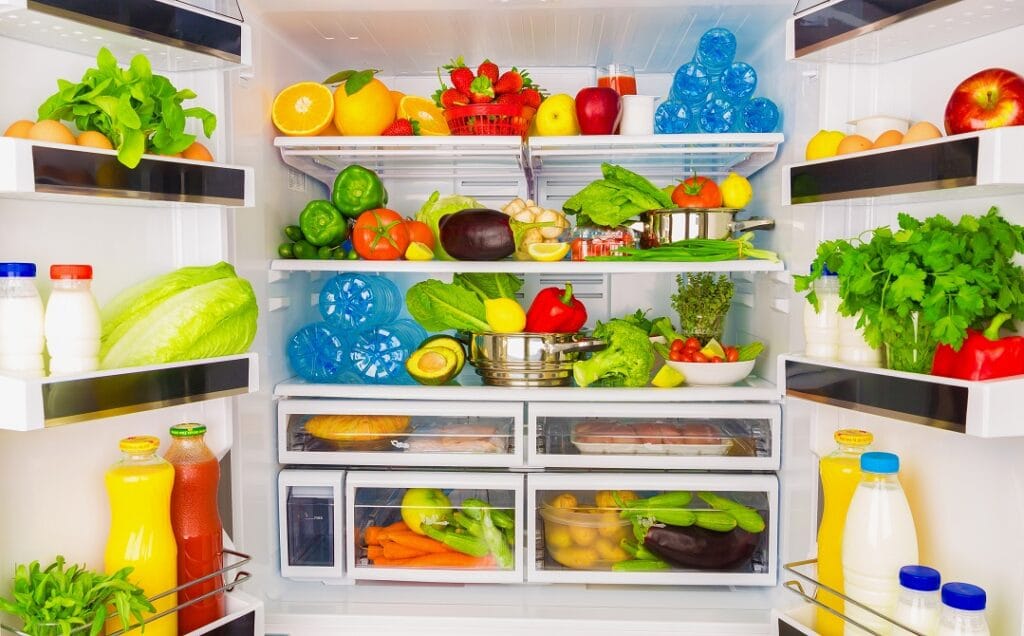If you’re trying to follow a low-carb diet, it can be a bit confusing to figure out which fruits and vegetables are best. Some are packed with hidden sugars and carbohydrates, while others can help you maintain a healthy, balanced low-carb lifestyle.
In this guide, we’ll take a look at the best fruits and vegetables for a low-carb diet. We’ll also discuss why these foods are essential for your health, how to incorporate them into your meals, and offer tips to make the most of your diet plan.
Whether you’re starting a ketogenic diet or just want to reduce your carb intake, this article will help you make smarter food choices.
Why Are Fruits and Vegetables Important on a Low-Carb Diet?
Even though low-carb diets focus on reducing carbohydrates, fruits and vegetables should still be a crucial part of your meals. They provide essential nutrients, vitamins, and fiber that help support your immune system, digestion, and overall well-being.
However, not all fruits and vegetables are created equal. Some contain more natural sugars or starch, which can increase your carb intake. This is why it’s important to choose wisely when following a low-carb eating plan.
Top Vegetables for a Low-Carb Diet
Vegetables are a staple in any healthy diet. When it comes to a low-carb diet, non-starchy vegetables are your best option. They are low in carbohydrates, high in fiber, and rich in vitamins and minerals.
Here are the best vegetables for a low-carb diet:
1. Spinach
Spinach is one of the most nutrient-dense vegetables you can add to your diet. It’s low in carbs, high in vitamins (like vitamin K and A), and full of antioxidants.
- Carbs per cup (raw): 1 gram
- How to use: Add spinach to salads, smoothies, or sauté it with some garlic for a tasty side dish.
2. Kale
Kale is another superfood that’s low in carbs and high in nutrients. It’s packed with vitamin C, vitamin K, and even a little protein.
- Carbs per cup (raw): 1.4 grams
- How to use: Make kale chips, toss it into soups, or use it as a base for salads.
3. Broccoli
Broccoli is an excellent choice for low-carb eaters. It’s rich in fiber, vitamins, and minerals like vitamin C and potassium.
- Carbs per cup (cooked): 6 grams
- How to use: Steam or roast broccoli for a simple side dish or add it to stir-fries.
4. Cauliflower
Cauliflower is incredibly versatile and can be used as a low-carb substitute for grains and starches. You can make cauliflower rice, mashed cauliflower, or even use it as a pizza crust.
- Carbs per cup (raw): 5 grams
- How to use: Use cauliflower as a base for your low-carb meals by making cauliflower rice or roasted cauliflower.
5. Zucchini
Zucchini is one of the lowest-carb vegetables, making it a fantastic choice for those on a low-carb or keto diet. It’s also very versatile and can be used in many dishes.
- Carbs per cup (raw): 4 grams
- How to use: Make zoodles (zucchini noodles), add it to stir-fries, or grill it for a delicious side.
6. Bell Peppers
Bell peppers, especially green ones, are relatively low in carbs compared to other vegetables. They are also high in vitamin C and other antioxidants.
- Carbs per medium pepper: 6 grams
- How to use: Slice them up for salads, use them in stir-fries, or stuff them with a low-carb filling.
7. Asparagus
Asparagus is a low-carb vegetable packed with fiber and nutrients like vitamin A, C, and K. It also has anti-inflammatory properties.
- Carbs per cup (cooked): 3.7 grams
- How to use: Grill, roast, or sauté asparagus for a quick and healthy side dish.
8. Cucumber
Cucumbers are light, refreshing, and extremely low in carbohydrates. They are mostly water but still provide some vitamins and minerals.
- Carbs per cup (sliced): 4 grams
- How to use: Add cucumber to salads, or enjoy it as a crunchy snack with some hummus or yogurt dip.
9. Lettuce
Leafy greens like lettuce are very low in carbs, making them perfect for a low-carb diet. Lettuce also provides a healthy dose of vitamin A and K.
- Carbs per cup: 2 grams
- How to use: Use lettuce as a wrap instead of bread, or make a big, crunchy salad.
10. Mushrooms
Mushrooms are low in carbs and calories, but rich in flavor and nutrients. They contain B vitamins and minerals like selenium.
- Carbs per cup (raw): 2.3 grams
- How to use: Sauté mushrooms with garlic, add them to soups, or toss them in salads.
YOU MAY ALSO LIKE: Keto Bread: Guide for Low-Carb Dieters
Best Fruits for a Low-Carb Diet
Fruits are naturally sweet, which means they contain sugars. However, there are certain fruits that are lower in carbs and can fit into a low-carb diet.
Here are the best fruits for a low-carb diet:
1. Avocado
Yes, avocado is technically a fruit! It’s high in healthy fats and very low in carbs, making it a top choice for low-carb and ketogenic diets.
- Carbs per avocado: 2 grams (net carbs)
- How to use: Mash avocado into guacamole, add it to salads, or eat it with eggs.
2. Berries (Strawberries, Raspberries, Blackberries)
Berries are some of the lowest-carb fruits and are packed with antioxidants and fiber. They can satisfy your sweet tooth without pushing you over your carb limit.
- Carbs per half cup (strawberries): 6 grams
- Carbs per half cup (raspberries): 3 grams
- Carbs per half cup (blackberries): 4 grams
- How to use: Add berries to your morning yogurt, use them as a snack, or blend them into a low-carb smoothie.
3. Coconut
Coconut is a unique fruit that’s high in fat and fiber but low in carbs. You can enjoy coconut meat, coconut milk, and even coconut oil as part of your low-carb diet.
- Carbs per 1 oz (shredded coconut): 2 grams
- How to use: Add shredded coconut to smoothies, desserts, or sprinkle it on top of yogurt.
4. Tomatoes
Although often considered a vegetable, tomatoes are actually a fruit. They are low in carbs and rich in vitamins like vitamin C and potassium.
- Carbs per cup (chopped): 7 grams
- How to use: Add tomatoes to salads, use them in sauces, or eat them raw with a sprinkle of salt and pepper.
5. Lemons and Limes
Lemons and limes are very low in carbs and add a burst of flavor to your dishes. They’re also high in vitamin C and can aid digestion.
- Carbs per medium lemon: 5 grams
- How to use: Squeeze lemon or lime juice over salads, fish, or vegetables for extra flavor.
6. Olives
Olives are another fruit that is low in carbs and high in healthy fats. They’re a great addition to a low-carb diet, especially for snacking or adding to salads.
- Carbs per 10 olives: 2 grams
- How to use: Add olives to salads, make tapenade, or eat them as a snack.
7. Starfruit (Carambola)
Starfruit is an exotic fruit that’s low in carbs and provides a good amount of vitamin C. It’s slightly tart and can be eaten on its own or added to fruit salads.
- Carbs per medium starfruit: 6 grams
- How to use: Slice starfruit and add it to salads or eat it as a fresh snack.
8. Peaches
Peaches can be part of a low-carb diet when eaten in moderation. They’re lower in carbs than some other fruits and offer vitamins and minerals like vitamin C and potassium.
- Carbs per medium peach: 14 grams
- How to use: Eat peaches as a snack or add them to low-carb desserts.

Here are the comparison bar charts for vegetables and fruits, showing their carbohydrate content per serving. On the left, you can see the carb content of various vegetables, while on the right, you have the same for different fruits. This can help you visually compare which options are lower in carbs for your low-carb diet.
How to Incorporate Low-Carb Fruits and Vegetables into Your Diet
Here are some simple tips for adding more low-carb fruits and vegetables to your meals:
- Start your day with veggies – Add spinach, mushrooms, or bell peppers to your morning eggs for a nutrient-packed breakfast.
- Use vegetables as substitutes – Try cauliflower rice instead of white rice, or use lettuce wraps instead of tortillas for a low-carb meal.
- Snack smart – Keep cucumber, celery sticks, or a handful of olives on hand for quick and healthy snacks.
- Add fruit in moderation – While fruits are healthy, they can still contain sugars. Stick to low-carb fruits like berries and avocados, and enjoy them in small portions.
- Experiment with new recipes – Try new ways of preparing your favorite vegetables. Roasting, grilling, or making vegetable-based soups can help you stay on track with your low-carb diet.
Conclusion
Eating a low-carb diet doesn’t mean you have to give up fruits and vegetables. By choosing the best fruits and vegetables for a low-carb diet, you can still enjoy delicious, nutritious foods while keeping your carbohydrate intake low.
Focus on non-starchy vegetables like spinach, kale, and zucchini, and opt for lower-carb fruits like berries and avocados. These foods will not only help you stay within your carb limits but also provide your body with the essential nutrients it needs to thrive.


